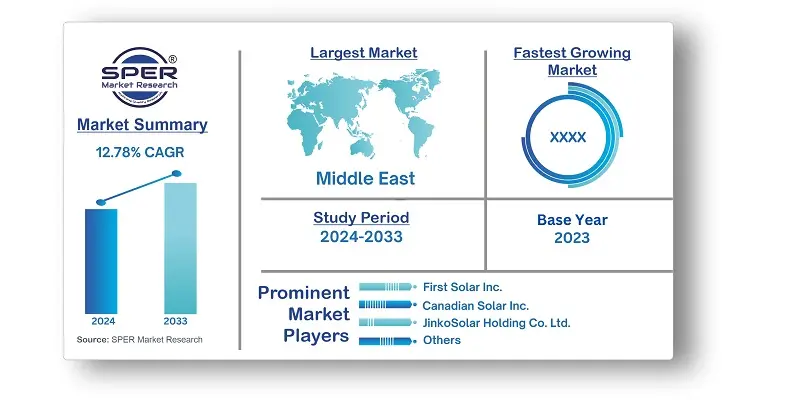
GCC Solar Photovoltaic Market Trends, Share, Size, Demand, Competition and Future Outlook
GCC Solar Photovoltaic Market Growth, Size, Trends Analysis- By Deployment- Regional Outlook, Competitive Strategies and Segment Forecast to 2033
| Published: Nov-2024 | Report ID: POAE2497 | Pages: 1 - 158 | Formats*: |
| Category : Power & Energy | |||
- The 300 MW Sakaka PV IPP, the nation's first utility-scale renewable energy project, was officially opened by ACWA Power in April 2021. The project cost SAR 1.2 billion to build. With an unprecedented tariff of USD 2.3417 cents/kWh (8.781 halalas/kWh), ACWA Power was given the project.
- The Hanergy Thin Film Power Group declared at the beginning of 2020 that it anticipated spending USD 1 billion (EUR 870 million) to construct a thin-film industrial park in Saudi Arabia. In addition, it will be the first park of its kind in the Middle East once the project is finished.


| Report Metric | Details |
| Market size available for years | 2020-2033 |
| Base year considered | 2023 |
| Forecast period | 2024-2033 |
| Segments covered | By Deployment. |
| Regions covered | United Arab Emirates, Saudi Arabia, Rest of GCC. |
| Companies Covered | Canadian Solar Inc., First Solar Inc., Masdar Abu Dhabi Future Energy Company, Dubai Electricity and Water Authority, ACWA Power, JinkoSolar Holding Co. Ltd, Trina Solar Co. Ltd, Sunergy Solar, Echo Solar Panels Manufacturing LLC, Emirates Insolaire, Others. |
- Government and Regulatory Authorities
- Solar Power Developers and EPC Contractors
- Investors and Financial Institutions
- Solar Panel Manufacturers and Suppliers
- Utility Companies and Energy Providers
- Commercial and Industrial Enterprises
- Residential Consumers
- Research and Development Organizations
| By Deployment: |
- GCC Solar Photovoltaic Market Size (FY’2024-FY’2033)
- Overview of GCC Solar Photovoltaic Market
- Segmentation of GCC Solar Photovoltaic Market By Deployment (Utlity, Commercial and Industrial, Residential)
- Expansion Analysis of GCC Solar Photovoltaic Market
- Problems and Obstacles in GCC Solar Photovoltaic Market
- Competitive Landscape in the GCC Solar Photovoltaic Market
- Impact of COVID-19 and Demonetization on GCC Solar Photovoltaic Market
- Details on Current Investment in GCC Solar Photovoltaic Market
- Competitive Analysis of GCC Solar Photovoltaic Market
- Prominent Players in the GCC Solar Photovoltaic Market
- SWOT Analysis of GCC Solar Photovoltaic Market
- GCC Solar Photovoltaic Market Future Outlook and Projections (FY’2024-FY’2033)
- Recommendations from Analyst
1.1. Scope of the report1.2. Market segment analysis
2.1. Research data source
2.1.1. Secondary Data2.1.2. Primary Data2.1.3. SPERs internal database2.1.4. Premium insight from KOLs
2.2. Market size estimation
2.2.1. Top-down and Bottom-up approach
2.3. Data triangulation
4.1. Driver, Restraint, Opportunity and Challenges analysis
4.1.1. Drivers4.1.2. Restraints4.1.3. Opportunities4.1.4. Challenges
4.2. COVID-19 Impacts of the GCC Solar Photovoltaic Market
5.1. SWOT Analysis
5.1.1. Strengths5.1.2. Weaknesses5.1.3. Opportunities5.1.4. Threats
5.2. PESTEL Analysis
5.2.1. Political Landscape5.2.2. Economic Landscape5.2.3. Social Landscape5.2.4. Technological Landscape5.2.5. Environmental Landscape5.2.6. Legal Landscape
5.3. PORTERs Five Forces
5.3.1. Bargaining power of suppliers5.3.2. Bargaining power of buyers5.3.3. Threat of Substitute5.3.4. Threat of new entrant5.3.5. Competitive rivalry
5.4. Heat Map Analysis
6.1. GCC Solar Photovoltaic Market Manufacturing Base Distribution, Sales Area, Product Type6.2. Mergers & Acquisitions, Partnerships, Product Launch, and Collaboration in GCC Solar Photovoltaic Market
7.1. GCC Solar Photovoltaic Market Size, Share and Forecast, By Deployment, 2020-20267.2. GCC Solar Photovoltaic Market Size, Share and Forecast, By Deployment, 2027-20337.3. Utlity7.4. Commercial and Industrial7.5. Residential
8.1. GCC Solar Photovoltaic Market Size and Market Share
9.1. GCC Solar Photovoltaic Market Size and Market Share By Region (2020-2026)9.2. GCC Solar Photovoltaic Market Size and Market Share By Region (2027-2033)9.3. United Arab Emirates9.4. Saudi Arabia9.5. Rest of GCC•
10.1. Canadian Solar Inc.
10.1.1. Company details10.1.2. Financial outlook10.1.3. Product summary10.1.4. Recent developments
10.2. First Solar Inc
10.2.1. Company details10.2.2. Financial outlook10.2.3. Product summary10.2.4. Recent developments
10.3. Masdar Abu Dhabi Future Energy Company
10.3.1. Company details10.3.2. Financial outlook10.3.3. Product summary10.3.4. Recent developments
10.4. Dubai Electricity and Water Authority
10.4.1. Company details10.4.2. Financial outlook10.4.3. Product summary10.4.4. Recent developments
10.5. ACWA Power
10.5.1. Company details10.5.2. Financial outlook10.5.3. Product summary10.5.4. Recent developments
10.6. JinkoSolar Holding Co. Ltd
10.6.1. Company details10.6.2. Financial outlook10.6.3. Product summary10.6.4. Recent developments
10.7. Trina Solar Co. Ltd
10.7.1. Company details10.7.2. Financial outlook10.7.3. Product summary10.7.4. Recent developments
10.8. Sunergy Solar
10.8.1. Company details10.8.2. Financial outlook10.8.3. Product summary10.8.4. Recent developments
10.9. Echo Solar Panels Manufacturing LLC
10.9.1. Company details10.9.2. Financial outlook10.9.3. Product summary10.9.4. Recent developments
10.10. Emirates Insolaire
10.10.1. Company details10.10.2. Financial outlook10.10.3. Product summary10.10.4. Recent developments
10.11. Others
SPER Market Research’s methodology uses great emphasis on primary research to ensure that the market intelligence insights are up to date, reliable and accurate. Primary interviews are done with players involved in each phase of a supply chain to analyze the market forecasting. The secondary research method is used to help you fully understand how the future markets and the spending patterns look likes.
The report is based on in-depth qualitative and quantitative analysis of the Product Market. The quantitative analysis involves the application of various projection and sampling techniques. The qualitative analysis involves primary interviews, surveys, and vendor briefings. The data gathered as a result of these processes are validated through experts opinion. Our research methodology entails an ideal mixture of primary and secondary initiatives.



Frequently Asked Questions About This Report
PLACE AN ORDER
Year End Discount
Sample Report
Pre-Purchase Inquiry
NEED CUSTOMIZATION?
Request CustomizationCALL OR EMAIL US
100% Secure Payment






Related Reports
Our Global Clients
Our data-driven insights have influenced the strategy of 200+ reputed companies across the globe.




















